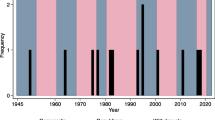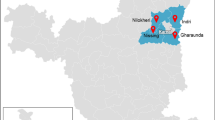Abstract
Policy feedbacks take place when public policies change mass participation and mobilize key constituencies. This can influence future rounds of policymaking and solidify government programs. We explore policy feedback in the context of a particularistic policy targeted to a specific electoral constituency: agricultural producers receiving payments from the U.S. Department of Agriculture (USDA). We exploit a novel dataset of: (1) payments distributed to producers by the USDA; and (2) participation in elections for the Farm Service Agency county committees that help administer these payments. The data are novel in that we rely on individual-level administrative histories of actual payments made by the USDA as well as documented forms of participation such as voting in elections and running for office. We find that receiving agricultural payments is associated with a 20% increase in the probability of voting in county elections, a 34% increase in the probability of running for office, and a 25% increase in the probability of winning office.


Similar content being viewed by others
Notes
A producer is defined as a farm “owner, operator, landlord, tenant or sharecropper, who shares in the risk of the agricultural product (crops, bees, livestock, etc.) and who is entitled to share in the product available from the farm, or would have shared had the product been produced” (see 7 CFR 718.2).
We draw upon Campbell (2012) for this review.
Clinton and Sances (2018), for example, use county-level measures of voter turnout and the percentage of citizens eligible for Medicaid. In contrast, the individual-level data used here do not require us to make ecological inferences.
Anzia and Moe (In press) explore a similar context where public sector unions hold positions on state boards that administer public pensions.
See https://www.fsa.usda.gov/Assets/USDA-FSA-Public/usdafiles/FactSheets/2018/COC_fact_sheet_may-2018.pdf for more information on county committees.
A local administrative area is a subdivision of the county. The area under a county committee’s jurisdiction is divided into three to five (but as many as eleven) administrative areas.
Producers are sometimes eligible to participate in the elections of another LAA if they hold farming interest in that county; these producers comprise approximately 3.1% of the sample of all producers.
An individual is allowed to nominate herself.
This program, along with the Average Crop Revenue Election (ACRE) program, were authorized only through the 2013 program year, and are now obsolete. DCP and ACRE were replaced by the Agricultural Risk Coverage (ARC) and Price Loss Coverage (PLC) programs for the 2014 through 2018 program years by the Agricultural Act of 2014 (2014 Farm Bill).
See https://www.fsa.usda.gov/FSA/webapp?area=home&subject=empl&topic=hbk for details regarding FSA committee responsibilities.
Results are similar when including producers who are registered as organizations (see Online Appendix Tables OA1 and OA2).
We also estimate models predicting whether they won the election and ended up serving on the committee, along with models predicting whether they served on the committee regardless of whether it was through an election or as a voting-member socially disadvantaged (SDA) appointment. We exclude non-voting advisors. Results are similar across the board (see Online Appendix Tables OA13 and OA14).
We add one dollar to all payment amounts so that the value of the independent variable is defined for producers.
We exclude the 0.62% of producers who ever received any negative payments as such cases suggest compensation for overpayment in previous years and we do not observe the full history of payments prior to 2009.
All models also include election year fixed effects. We present linear models for ease of interpretation. In Online Appendix Tables OA5-OA8, we report pooled logistic regressions as well as logistic regressions with producer fixed effects (i.e., conditional logit) (Chamberlain 1980) and obtain similar results. The conditional logit model addresses the incidental parameters problem in logistic regression (Beck 2018).
Producers clearly have other means of political influence beyond participation in county committee elections such as major party membership, campaign donations, and involvement with industry associations.
Although outside the focus of the current study, we note that these results also underscore the importance of outreach programs organized by the USDA in order to enhance participation in COC elections. To the extent that these mobilization programs are successful they could not only increase participation on average but also level the current gaps in participation across producers who receive differing payment amounts.
References
Anzia, S. F., & Moe, T. M. (2016). Do politicians use policy to make politics? The case of public-sector labor laws. American Political Science Review, 110(4), 763–777.
Anzia, S. F., & Moe, T. M. (In press). Interest groups on the inside: The governance of public pension funds. Perspectives on Politics.
Beck, N. (2018). Estimating grouped data models with a binary dependent variable and fixed effects: What are the issues? arXiv:1809.06505.
Burden, B. C. (2000). Voter turnout and the national election studies. Political Analysis, 8(4), 389–398.
Campbell, A. L. (2003). How policies make citizens: Senior political activism and the American welfare state. Princeton, NJ: Princeton University Press.
Campbell, A. L. (2012). Policy makes mass politics. Annual Review of Political Science, 15, 333–351.
Chamberlain, G. (1980). Analysis of covariance with qualitative data. Review of Economic Studies, 47(1), 225–238.
Clinton, J. D., & Sances, M. W. (2018). The politics of policy: The initial mass political effects of medicaid expansion in the states. American Political Science Review, 112(1), 167–185.
Feigenbaum, J., Hertel-Fernandez, A., & Williamson, V. (2018). From the bar- gaining table to the ballot box: Political effects of right to work laws. Cambridge: National Bureau of Economic Research.
Hastie, T. J., & Tibshirani, R. J. (1990). Generalized additive models. New York: Chapman and Hall.
Ingram, H., & Schneider, A. (1993). Constructing citizenship: The subtle messages of policy design. In H. Ingram & S. Rathgeb (Eds.), Public policy for democracy (pp. 68–94). Washington, DC: Brookings Institution Press.
Lerman, A. E., & McCabe, K. T. (2017). Personal experience and public opinion: A theory and test of conditional policy feedback. The Journal of Politics, 79(2), 624–641.
Lowi, T. J. (1964). American business, public policy, case-studies, and political theory. World Politics, 16(4), 677–715.
Lowi, T. J. (1969). The end of liberalism: Ideology, policy, and the crisis of public authority. New York: W.W. Norton.
Mettler, S. (2005). Soldiers to citizens: The G.I. Bill and the making of the greatest generation. New York: Oxford University Press.
Pierson, P. (1993). When effect becomes cause: Policy feedback and political change. World Politics, 45(4), 595–628.
Schattschneider, E. E. (1935). Politics, pressures, and the tariff. New York: Prentice Hall.
Soss, J. (1999). Lessons of welfare: Policy design, political learning, and political action. American Political Science Review, 93(2), 363–380.
Weaver, V. M., & Lerman, A. E. (2010). Political consequences of the carceral state. American Political Science Review, 104(4), 817–833.
White, A. (2019). Misdemeanor disenfranchisement? The demobilizing effects of brief jail spells on potential voters. American Political Science Review, 113(2), 311–324.
Wilson, J. Q. (1973). Political organizations. New York: Basic Books.
Author information
Authors and Affiliations
Corresponding author
Additional information
Publisher's Note
Springer Nature remains neutral with regard to jurisdictional claims in published maps and institutional affiliations.
Author names in reverse alphabetical order. We thank officials at the U.S. Department of Agriculture for their support and assistance. We thank Sarah Anzia, Joshua Clinton, Michael Sances, Zach Taylor, and Carlos Varjão for valuable feedback on earlier drafts. Replication materials can be found at Neil Malhotra’s Harvard Dataverse: https://doi.org/10.7910/DVN/ZATAJM.
Electronic supplementary material
Below is the link to the electronic supplementary material.
Rights and permissions
About this article
Cite this article
Simonovits, G., Malhotra, N., Lee, R.Y. et al. The Effect of Distributive Politics on Electoral Participation: Evidence from 70 Million Agricultural Payments. Polit Behav 43, 737–750 (2021). https://doi.org/10.1007/s11109-019-09572-7
Published:
Issue Date:
DOI: https://doi.org/10.1007/s11109-019-09572-7




